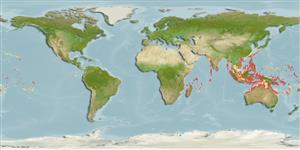Preferred temperature (Ref.
123201): 26.3 - 29.3, mean 28.5 °C (based on 2345 cells).
Phylogenetic diversity index (Ref.
82804): PD
50 = 0.5000 [Uniqueness, from 0.5 = low to 2.0 = high].
Bayesian length-weight: a=0.01585 (0.00707 - 0.03555), b=2.95 (2.76 - 3.14), in cm total length, based on LWR estimates for this (Sub)family-body shape (Ref.
93245).
Trophic level (Ref.
69278): 3.4 ±0.45 se; based on food items.
Widerstandsfähigkeit (Ref.
120179): hoch, Verdopplung der Population dauert weniger als 15 Monate. (Preliminary K or Fecundity.).
Fishing Vulnerability (Ref.
59153): Low vulnerability (10 of 100).
Nutrients (Ref.
124155): Calcium = 99.2 [57.4, 186.1] mg/100g; Iron = 0.867 [0.498, 1.658] mg/100g; Protein = 18.2 [15.3, 20.4] %; Omega3 = 0.162 [0.095, 0.273] g/100g; Selenium = 22.6 [12.7, 44.7] μg/100g; VitaminA = 256 [76, 929] μg/100g; Zinc = 1.75 [1.17, 2.77] mg/100g (wet weight);
